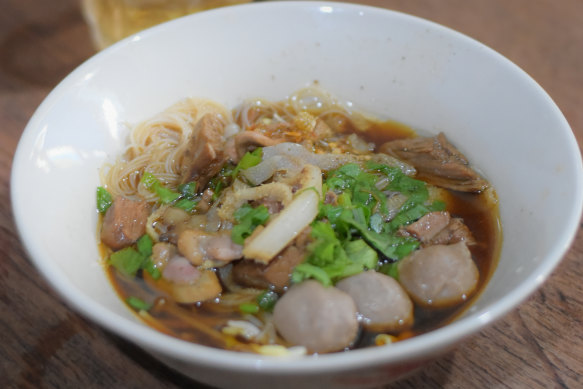We all know pho, but few Australians have tried the Cambodian equivalent
The dish
Kuyteav, Cambodia
Plate up

Kuy teav, the clear, pork- and dried-shrimp-based broth and its various toppings.Credit: iStock
By this point pretty much every Australian is aware of the existence of pho, the Vietnamese noodle soup with its subtly spiced broth that is available everywhere from Westfield food courts to suburban high streets. But how about kuyteav, the Cambodian equivalent that’s so popular, many Vietnamese claim a version of it as their own?
Kuyteav tends to vary depending on where it’s served: in Cambodia, it will be a light, clear, pork- and dried-shrimp-based broth with slippery, flat rice noodles, topped with various cuts of pork, plus fresh herbs and aromatics.
In Vietnam, where it’s known as hu, the broth will be similar, though the noodles will be chewier, possibly made with tapioca to differentiate the dish from pho, and topped with pork, prawns, fried garlic and Chinese celery. Either way, it’s breakfast perfection.
First serve
Don’t get a Cambodian started on the Vietnamese propensity to claim hu tieu as their own invention. Even those Vietnamese who do acknowledge the dish’s origins as kuyteav in Phnom Penh tend to stress that it was developed by Chinese Teochew migrants rather than local Cambodians.
And while we’re not here to draw lines or engage in any cross-border skirmishes, it is widely believed that kuyteav appeared in the markets of Phnom Penh in the early 20th century, and its popularity spread into Vietnam when those Teochew migrants began moving into the Mekong Delta area. It’s now a much-loved staple in both countries.
Order there
In Cambodia, the Phsar Chas, or Old Market, in Phnom Penh is widely believed to be the place kuyteav first appeared, and there are still plenty of vendors dishing it up there today (tourismcambodia.org).
Order here
In Sydney, you can sample excellent kuyteav (labelled “Phnom Penh rice noodle”) at Battambang Restaurant in Cabramatta (14-16/70 John Street). In Melbourne, try the dish (here called kuy teav) at Angkor Cafe in West Melbourne (angkor.cafe).
One more thing
To show how popular hu tieu is in Vietnam, there are now three well-known regional variations: nam vang, the most similar to Cambodian kuyteav; my tho, with thinner, chewier noodles and prawn topping; and sa dec, with thicker, though less chewy noodles.
Sign up for the Traveller Deals newsletter
Get exclusive travel deals delivered straight to your inbox. Sign up now.